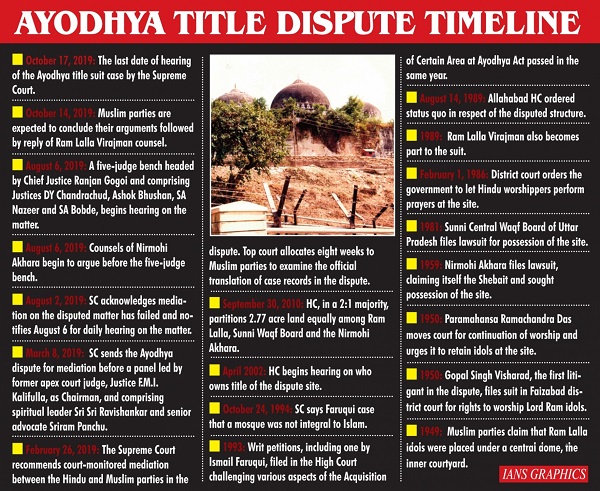New Delhi, Is the devades-old Ayodhya title suit case reaching a closure?
The Supreme Court has fixed October 17 as the last date of hearing in the matter, which has huge political and religious overtones.
A judgement by the top court is expected by November 17, the day Chief Justice of India Ranjan Gogoi retires.
The last leg of hearing this week will see senior advocate Rajeev Dhavan, appearing for Sunni Waqf Board, continuing his arguments on the Muslim body’s lawsuit claiming possession of the disputed site.
Dhavan has made bulk of arguments from the Muslims’ side. This crucial week will see Muslim parties’ wrapping up their final submissions before the five-judge bench headed by Chief Justice Ranjan Gogoi and comprising Justices S.A. Bobde, Ashok Bhushan, D.Y. Chandrachud and S.A. Nazeer.
Dhavan has been at the forefront of contesting Muslim’s claim on the disputed site. At 73, he is only lawyer, out of plethora of counsels engaged in the case, who have argued on the matter for more than two weeks.
He has single-handedly contested every strand of argument advanced by Hindu parties’ counsels, though he was assisted by short spell of arguments by three other senior lawyers.
In contrast, Hindu parties have adopted a strategy where every counsel has been allocated a designated scope of arguments — senior advocate K. Parasaran argued on birthplace of Lord Ram as a legal entity; senior advocate C.S. Vaidyanathan argued on the conclusion of the ASI report; senior advocate P.N. Mishra argued on Islamic law; and senior advocate Sushil Jain argued for Nirmohi Akhara.
The Hindu parties’ have consistently argued that the ASI report, which concludes presence of a Hindu temple below the mosque, corroborated by travelogues and Gazetteers of Western visitors identifying the Hindu belief and faith on the birthplace of Lord Ram, weighs high on evidentiary value establishing their arguments.
The Muslim parties have contested this strand of argument, saying the ASI report is inconclusive and riddled with inconsistencies; and travelogues are mere stories, which cannot be relied as a crucial piece of evidence.
The Muslim parties have also strongly contested Hindus’ side arguments terming the birthplace of Lord Ram under the central dome as a legal entity. Muslim parties have argued that and is not Swayambhu, self-existing, whereas Kailash Mansarovar is an accurate example of manifestation.
Though, cumulatively Hindu parties’ counsels have consumed less time, on the arguments claiming its rightful possession on the disputed site, but have maintained sharp and effective response to the queries posed before them by judges on the bench. They avoided being repetitive whereas judges have objected the opposite party for repeating its arguments.
The last-leg of the arguments is anticipated to draw sharp reaction from both — bench and the lawyers.
Dhavan had already set the tone. He had vehemently opposed the Hindu parties’ counsel from introducing fresh evidence and also countered a volley of queries from the judges.
Before the Dussehra vacations, Justice Bobde and Dhavan exchanged some sharp comments on the nature of divinity in Islam.
Justice Bobde quizzed Dhavan, “divinity can be attributed to Hinduism, but not Islam, and we are asking you?” Dhavan replied mosque is always divine. Bobde queried, “It is dedicated to Allah, how is it divine?”
Dhavan quipped Muslim pray five times to Allah in a mosque, therefore it is divine.
Unsatisfied with Dhavan’s reply, Bobde said: “We like to see some authoritative text from some scholar.”
Interestingly, Dhavan has also been the only counsel who has been extensively quizzed by judges on his arguments.
After Dhavan’s arguments, Hindu parties’ counsels are expected to complete their reply on the Muslim side lawsuit by mid of Wednesday followed by arguments by other parties’ who are yet to place their arguments on the matter.










